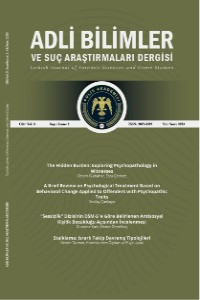Terörün Yeni Yüzü: Biyolojik Terör
Terör, Terörizm, Biyoterör, Biyolojik Savaş
The New Face of Terror: Biological Terror
Terror, Terrorism, Bioterrorism, Biological Warfare,
___
- Allard M.W., Bell R., Ferreira C.M., Gonzalez-Escalona N., Hoffmann M., Muruvanda T., Ottesen A., Ramachandran P., Reed E., Sharma S. (2018). Genomics of Foodborne Pathogens for Microbial Food Safety, Curr. Opin. Biotechnol. 49, pp. 224–229.
- Amorim A. (2010). Introduction to the Special issue on forensic genetics: non-human DNA (Guest Editor: Antonio Amorim), Open Forensic Sci. J., pp. 3.
- Araújo R., Pereira F., Asch Bv. (2017). Applications of DNA-Based Methods in Food Forensics, Handbook Of Forensic Genetics: Biodiversity And Heredity n Civil And Criminal Investigation, pp. 493–517.
- Arenas, M., Pereira, F., Oliveira, M., Pinto, N., Lopes, A.M., Gomes, V., Carracedo, Amorim, A. (2017). Forensic genetics and genomics: much more than just a human affair, PLoS Genet. 13, e1006960.
- Atlas, R. M.(1999). Combating the threat of biowarfare and bioterrorism: defending against biological weapons is critical to global security, BioScience, 49, pp. 465-477.
- Barras, V., Greub, G. (2014). History of biological warfare and bioterrorism, Clin. Microbiol. Infect., 20, pp. 497-502.
- Beeching, N.J., Dance, D.A., Miller, A.R., Spencer, R.C. (2002). Biological warfare and bioterrorism, BMJ 324, pp. 336–339.
- Bronze M.S., Huycke M.M., Machado L.J., Voskuhl G.W., Greenfıeld R.A. (2002). Viral agents as biological weapons and agents of bioterrorism, the American Journal of The Medical Sciences, 323, 6, pp. 316-325.
- Budowle B., Schutzer S.E., Einseln A., Kelley L.C., Walsh A.C., Smith J.A., Marrone B.L., Robertson J., Campos J. (2002). Building microbial forensics as a response to bioterrorism, American Association for the Advancement of Science, 2003, 301, 5641, pp. 1852-1853.
- Carus, W.S. (2017). A Short History of Biological Warfare: From Pre-history to the 21st Century Government Printing Office
- Christopher, L.G.W., Cieslak, L.T.J., Pavlin, J.A., Eitzen, E.M. (1997). Biological warfare: a historical perspective, JAMA, 278, pp. 412-417.
- Danley L. (2012). Duties and difficulties of ınvestigating and prosecuting biocrimes, J. Biosecur. Biosaf. Biodefense Law, 3.
- Di Pasquale S., Paniconi M., Auricchio B., Orefice L., Schultz A.C., De Medici D. (2010). Comparison of different concentration methods for the detection of hepatitis a virus and calicivirus from bottled natural mineral waters, J. Virol. Methods 165, pp. 57–63.
- Eitzen, E.M. (1997). Use of biological weapons, Medical Aspects of Chemical and Biological Warfare, pp. 437-450.
- González-Candelas F. (2017). Molecular epidemiology and evolution concepts in microbial forensics, Handbook of Forensic Genetics: Biodiversity and Heredity in Civil and Criminal Investigation, World Scientific, pp. 561–582.
- Jansen, H.-J., Breeveld, F.J., Stijnis, C. , Grobuschm, M.P. (2014). Biological warfare, bioterrorism, and biocrime Clin. Microbiol. Infect., 20, pp. 488-496
- Karwa M., Currie B., Kvetan V. (2005). Bioterrorism: preparing for the ımpossible or the ımprobable, Crit. Care Med. 33, 1, pp.S75-S95.
- Keim, P.S. , Budowle, B., Ravel, J. (2011).Microbial forensic investigation of the anthraxletter attacks, Microbial Forensics, Elsevier, pp. 15–25.
- Khan, A.S., Amara, P.S., Morse, S.A. (2020). Forensic public health: epidemiological and microbiological investigations for biosecurity, Microbial Forensics, Elsevier, pp. 105–122.
- Khardori, N., Kanchanapoom, T. (2005). Overview of biological terrorism: potential agents and preparedness, Clin. Microbiol. Newsl., 27, pp. 1-8
- Knutsson R., Van Rotterdam Fach B.P., De Medici D., Fricker M., Löfström C., Ågren J., Segerman B., Andersson G., Wielinga P. (2011). Accidental and deliberate microbiological contamination in the feed and food chains—how biotrace-ability may improve the response to bioterrorism, Int. J. Food Microbiol. 145, pp. 123–128.
- Kortepeter M.G. and Parker G.W.(1999). Potential biological weapons threats, emerging ınfectious diseases, Vol. 5, No. 4, pp. 523-527.
- Lehman, D.C. (2014). Forensic microbiology Clin. Microbiol. Newsl., 36, pp. 49-54.
- Murch R.S. (2015). Bioattribution needs a coherent international approach to improve global biosecurity, Front. Bioeng. Biotechnol. 3, p. 80.
- Murch R.S. (2014). Designing an effective microbial forensics program for law enforcement and national security purposes, Arch. Immunol. Ther. Exp. 62, pp. 179–185.
- Murch R.S. (2003). Microbial Forensics: Building a National Capacity to Investigate Bioterrorism, Biosecur. Bioterror. 1, pp.117–122.
- Oliveira M., Amorim A. (2018a). Microbial forensics: new breakthroughs and future prospects, Appl. Microbiol. Biotechnol. 102, pp. 10377–10391.
- Oliveira M., Arenas M., António A. (2018b). New trends in microbial epidemiology: can an old dog learn new tricks?, Ann. Microbiol. Immunol. 1, pp. 1–7.
- Pavlin, J.A. (1999). Epidemiology of bioterrorismm, Emerg. Infect. Dis., 5, p. 528
- Schutzer S.E., Budowle B., Atlas R.M. (2005). Biocrimes, microbial forensics and the physician, PLoS Med. 2, p. e337.
- Seth C. W. (2008). Bioterrorism and Biocrimes, Chapter 2, pp. 42-96.
- Szinicz, L. (2005). History of chemical and biological warfare agents, Toxicology, 214, pp. 167-181.
- Tucker J.B. (1999). Historical trends related to bioterrorism: an empirical analysis, emerging ınfectious diseases, Vol. 5, No. 4, pp. 498-504.
- ISSN: 2687-3397
- Başlangıç: 2020
- Yayıncı: Polis Akademisi
Çevrenin Kasten Kirletilmesi Suçu
Adli Toksikolojik Analizlerde Gözardı Edilebilen Bir Aşama: Yorumlamadan Verilen Yanlış Sonuçlar
Rukiye ASLAN, Serap Annette AKGÜR, Ezgi EMEN
Biyolojik Silahların Gelişimi ve Uluslararası Hukuktaki Yeri
Adli Vakaların Çözümlenmesi ve Güvenlik Amacıyla Parmak İzinin Alınmasının Önemi
Doğukan ÖLMEZ, Elif ÇETLİ, Demet TATAR, Vahdet ÖZKOÇAK
Adli Bilimlerde Kriminalistik ve Luminol
